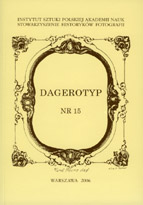Fotografia i archeologia
Photography and Archaeology
Author(s): Adam SobotaSubject(s): Photography
Published by: Instytut Sztuki Polskiej Akademii Nauk
Keywords: photography; Polish photography; vintage photography; old photographic technique; archeology; exoticism; romanticism; Niedźwiedzki; Stanislaw; Jelenia Góra; Hirschberg; Persia
Summary/Abstract: The photographic archive left after Stanisław Niedźwiecki served at the end of 2005 as the pretext to broadly present his works from Persia. The latter were grounded on the 100 preserved films, currently copied on photographic barite paper following a homogenized archaized convention. About 20 original prints of the Author have enriched this collection (from among ca. 180 of his copies, being in majority working ones), which allowed for a certain confrontation. The spectators have been offered the opportunity to reflect on what getting to know old photographs means today. We hardly ever are presented with the opportunity to realise what alterations can be introduced by the presenter of archival records, and how they were displayed originally. Stanisław Niedźwiecki was born at Szajkuny – the then Vilnius province – in 1890. He acquired education in Russian schools and prior to World War I he studied anthropology and ethnography at St. Petersburg University. After the revolution of 1917 he ended up in the Caucasus and it was there that he began taking photographs. Starting from ca. 1921 until 1935 he was in Persia as a hired photographer with archaeological expeditions. He returned to his home at the beginning of 1936, joining the movement of native photography initiated by Jan Bułhak. In 1945 he settled in Jelenia Gora where he ran the studio of landscape and artistic photographs at the Youth Culture Centre. He died in Jelenia Gora in 1976, and a part of his archive has been preserved by his colleagues from the Jelenia Gora Photographic Association. Photographs from Persia inspired me to reflect on the relation between photography and archaeology. The task to report on the archaeological monuments and works of art ranks among the source ideas justifying the presence of photography in culture. This was enhanced already by Francois Arago propagating the invention of Daguerre in 1839 or by Fox Talbot. The photographs of Stanisław Niedźwiecki can be seen as a confrontation between the European and Persian cultural traditions. Photography is derived from the idea of the Renaissance rationality and the need to democratise culture. Persian art survived until the 20th century in the forms shaped in the Middle Ages. A question can be asked whether by glimpsing on the people attending to their everyday business through the eye of the camera, we can perceive the picture differently than this culture perceived itself. Are romanticism and exoticism notions that can be generated from a different stand? It is a fact that presently the principles of photography are applied everywhere and by everyone in a very similar way. When Niedźwiecki was in Persia, there were only a handful of native photographers. A today’s tourist who hunts for exoticism in different parts of the world perceives the latter in a similar way as numerous local camera owners.
Journal: Dagerotyp
- Issue Year: 2006
- Issue No: 15
- Page Range: 22-34
- Page Count: 13
- Language: Polish
- Content File-PDF

